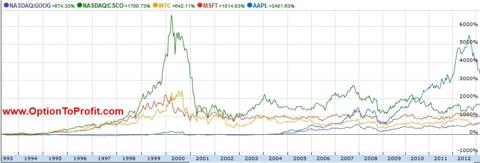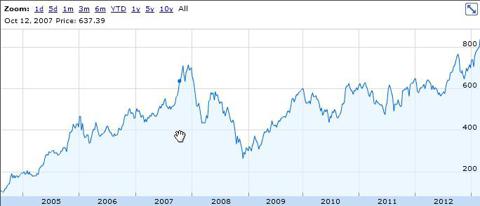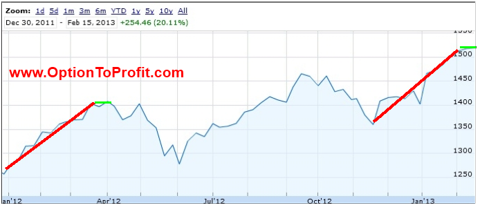 The age old question and certainly having its application in the stock markets is how does one see the glass. Is it half full or half empty? Is the market going higher from the current levels or have we already seen its best days?
The age old question and certainly having its application in the stock markets is how does one see the glass. Is it half full or half empty? Is the market going higher from the current levels or have we already seen its best days?
I often like to say that I neither believe in technical nor fundamental analyses. Saying so is probably a reflection of the denial that has me refusing to believe that my intellectual capacity has greatly diminished.
While not really spending terribly much time with charts, I do glance at them. Like the spooky kid from “The Sixth Sense,” I do think I occasionally see patterns. I suppose to some degree that’s somehow related to a very basic aspect of technical analysis.
About a month ago, I started getting a bit leery about the market’s climb and have found it increasingly difficult to commit funds to new positions. That feeling was based upon what I perceived to be a very similar path that the market was following to that exhibited in the beginning of 2012.
Both paths are the kind that covered option sellers dislike, but fortunately don’t come along very often. Both times the market has essentially done nothing but climb higher.
This Thursday morning we’re fresh off closing higher nine straight days. In fact, March 2013 has yet to see a lower close. Needless to say, my prescience has yet to be fulfilled.
The last time that the market enjoyed a nine day winning streak was in November 1996 and it do so in May 1996, as well. I can say “enjoyed” because back then i wasn’t selling call options, so I’m fairly certain that I enjoyed those periods as well.
Out of curiosity and with an abundance of time on my hands as I await something to break in one direction or another, I was interested in seeing just how the market has done historically following such consistent daily climbs higher.
The short and quick answer is that such climbs in the S&P 500 or its related trading products, such as SPDR S&P 500 ETF (SPY) do not result in a reactive and sharp drop once the string of advances has come to an end. The market continues to climb.
So much for my theory and hopes that I could return to the more fulfilling days of trading ups and downs in the market.
 While the current advance should, therefore, be a source of continued optimism, there may be a competing dynamic to be considered.
While the current advance should, therefore, be a source of continued optimism, there may be a competing dynamic to be considered.
Looking at the bigger picture, beginning in May 1996, when that first 9 day advance occurred, which happened to be at the beginning of a secular market climb, it seems as if some kind of pattern was appearing.
Looking at the 17 year period illustrated above there may be some reason to believe that we are in the process of completing a 52 month cycle.
In each of the two previous broad and sustained market rallies the time frame has been approximately 52 months and the rallies have been on the order of 100% or greater. For those not chased out of the market as the nadirs were reached the recoveries were satisfying.
However, that satisfaction may have been tempered by the large market drops that ensued. In both previous cases the market plunged more than 40% over the course of the subsequent 18-30 months. Greed, optimism, a sense of invincibility may all have been factors in being caught in the continued downdrafts that devoured paper profits.
In hindsight, there were certainly precipitating factors that may have played a role in these drops, not all of which could have been predicted.
While perhaps the technology bubble should have been no surprise, nor should the real estate bubble, extrinsic factors, such as the terrorist attack of September 11, 2001 contributed to market declines during an already susceptible period. However, in the period from May 1996 to the present, there have also been an astonishing 18 periods of time when the market fell 10% or more.
As hard as it is to understand that the occasional fire that burns down a beloved forest is part of a cycle that sustains and evolves the environment, so too are those market declines an apparently necessary, or at least unavoidable component of reaching greater heights.
Clearly, and again, focusing on the big picture, those intermediate declines have been part of a healthy process as the S&P 500 has appreciated by more than 130% since that nine day trading range in 1996. Of course, that’s little solace to those that did see their profits disappear and that may have exited the market and greatly delayed their re-entry.
Being prepared for those declines is the tricky part. Balancing the need to be invested with the knowledge that much of your good work can be undone by a simple hiccough is disconcerting.
As we are now in the fifth year of the current climb and may be appro
aching that wall that we’ve seen twice before in the past 17 years, I continue to believe that there is ample reason to create reserves and take profits, even if that means leaving some on the table. Transitioning a portfolio may be a good strategy to gradually respond to future uncertainty.
In my case, that means being less likely to rollover covered contracts into the next cycle and instead being happy to see share assignments and realization of cash proceeds. It may also mean writing longer term contracts for those positions not likely to be assigned and grabbing larger premiums, albeit at lower time adjusted ROIs, in order to have a better chance of riding out any reversal.
Timing the market is something that most sane people would agree is impossible, certainly on a consistent basis. Everyone has the same charts to look at, yet the interpretations are in a wide range, often fitting personal outlooks and human emotions. The cynic and the optimist see the same data very differently and respond consistent with their own biases.
I am, by nature, a long term optimist, but a short term pessimist. Rarely, however, have I felt this level of pessimism. Sadly, I didn’t feel it in 2007, even after first having one of those warning mini- drops of 8% in July 2007.
The nice thing about being wrong is that you can always get back, although given that scenario, I have to believe that I would be even more pessimistic, as I don’t care to chase stocks as they’ve moved higher.
The other nice thing is as today (Thursday March 14, 2013) is thus far shaping up to be the 10th straight day of gains, I can look at the data all over again and perhaps arrive at a completely different conclusion.
Just like the professionals.






 No, it’s the end of yet another options cycle in just a few short days. Time to see if there are any crumbs left out there just waiting to be taken. And you do have to act quickly, because before you know it those crumbs get smaller and smaller, before they disappear entirely.
No, it’s the end of yet another options cycle in just a few short days. Time to see if there are any crumbs left out there just waiting to be taken. And you do have to act quickly, because before you know it those crumbs get smaller and smaller, before they disappear entirely.